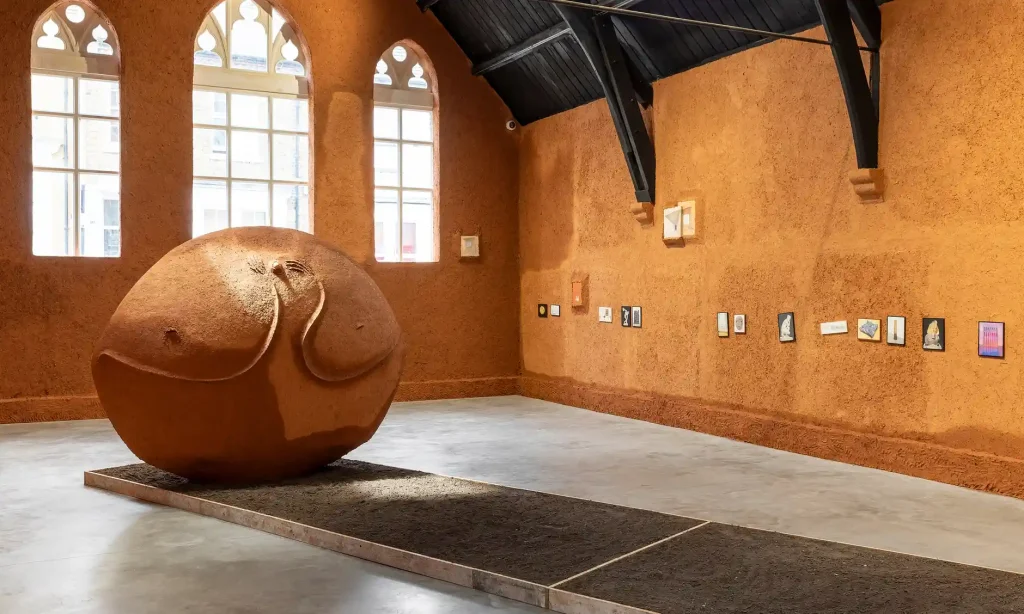In the heart of an art gallery, a captivating exhibition titled “Usos y Costumbres” comes to life. Buenos Aires painter Laura Ojeda Bär skilfully renders Douglas Gordon’s profound text “I am the curator of my own misery” in small oil paintings. Yet, Bär goes beyond the confines of the text, meticulously painting the very walls upon which it was originally inscribed. The result is a mesmerising fusion of words and surfaces that form part of an installation created by Argentinian sculptor Gabriel Chaile. Together, these two artists present a captivating interplay of art, identity, and migration, weaving an intricate tapestry of narratives that engage the senses and provoke contemplation.
Chaile’s Adobe Walls and Enigmatic Sculptures
Gabriel Chaile transforms the gallery space into an immersive experience by cladding the walls with false surfaces made of adobe, an ancient building material comprising mud, clay, and straw. Hailing from northern Argentina, Chaile incorporates adobe into his sculptural works, often resembling mythical creatures and everyday objects. One centrepiece of the exhibition is a remarkable sculpture reminiscent of a great clamshell adorned with serpentine arms, an enigmatic eye, and a mysterious egg-like form on its forehead. These sculptures stand as testaments to the artist’s cultural heritage, which is a complex blend of Afro-Arabic, Spanish, and Indigenous Candelaria influences.
Bär’s Precise and Puzzling Paintings
Laura Ojeda Bär’s paintings hang within the adobe-clad walls, offering a striking contrast between muted precision and puzzling disarray. Bär carefully selects artworks from Tate and other British collections, each canvas appearing to engage in an animated conversation with its neighbours. The paintings sometimes hang askew, teasing viewers with their paradoxical balance of equilibrium and disorder. Chaile’s adobe surfaces bear intentional inscriptions, almost like symbols or cryptic messages, adding an enigmatic touch to the overall exhibition.
Collaborative Narratives and Cultural Migrations
As viewers delve deeper into “Usos y Costumbres,” they encounter larger paintings that blur the lines between artist and subject. Chaile’s woozily distorted portrait and Bär’s self-portrait with surreal transformations embody the collaboration between the artists, the audience, and the space itself. The perspectives shift, and architectural illusions come to life, offering breathtaking views of skies, light, and a hint of the ethereal. Moreover, a plastic megaphone with the slogan “Migrants Welcome” in Portuguese, which Chaile encountered during the first Covid lockdown in Lisbon, embodies the interconnectedness of art, culture, and migration.
Reflecting on the Gallery’s Past and Present
The gallery itself has a storied history, once serving as an annexe to a former Methodist church that was tragically destroyed during the blitz. Amid the dim warmth of the adobe interior, Chaile and Bär’s art pays subtle homage to this past. The exhibition becomes a space that transcends physical boundaries, inviting contemplation on the passage of time, the interplay of diverse influences, and the resilience of art and humanity in the face of destruction and renewal.
A Sanctuary of Respite and Reverie
In the harmonious collaboration of Laura Ojeda Bär and Gabriel Chaile, “Usos y Costumbres” emerges as a sanctuary of respite from the complexities of life. Their combined works evoke a sense of interconnectedness, inviting viewers to contemplate the delicate balance between stability and change, art and life, past and present. As visitors traverse this intricate and multilayered installation, they embark on a journey that encourages introspection, sparking a dialogue on art, identity, and the enduring resilience of the human spirit. Through their mesmerising blend of mediums and perspectives, Chaile and Bär create an immersive experience that leaves a lasting imprint on the soul.

Contributor





